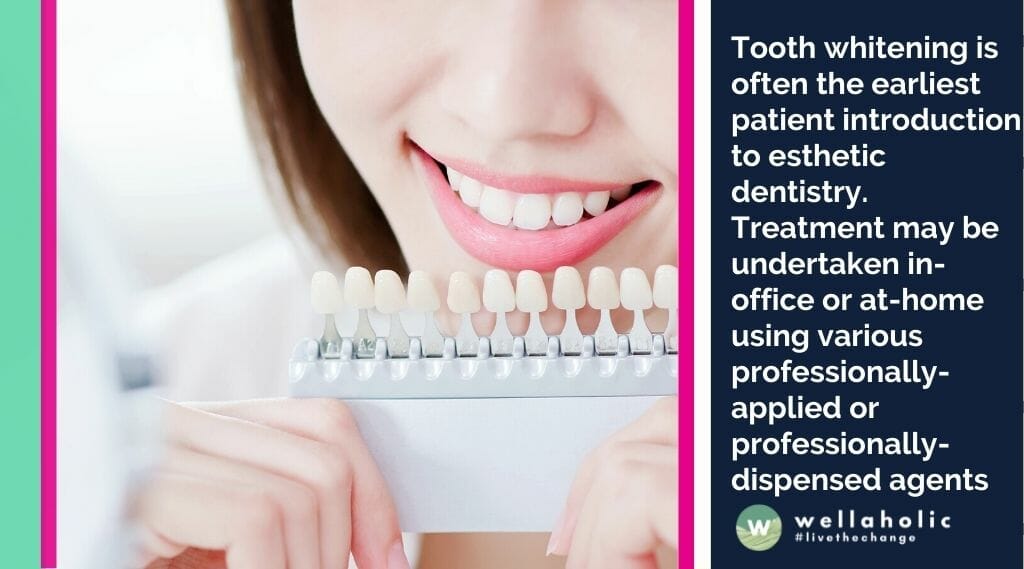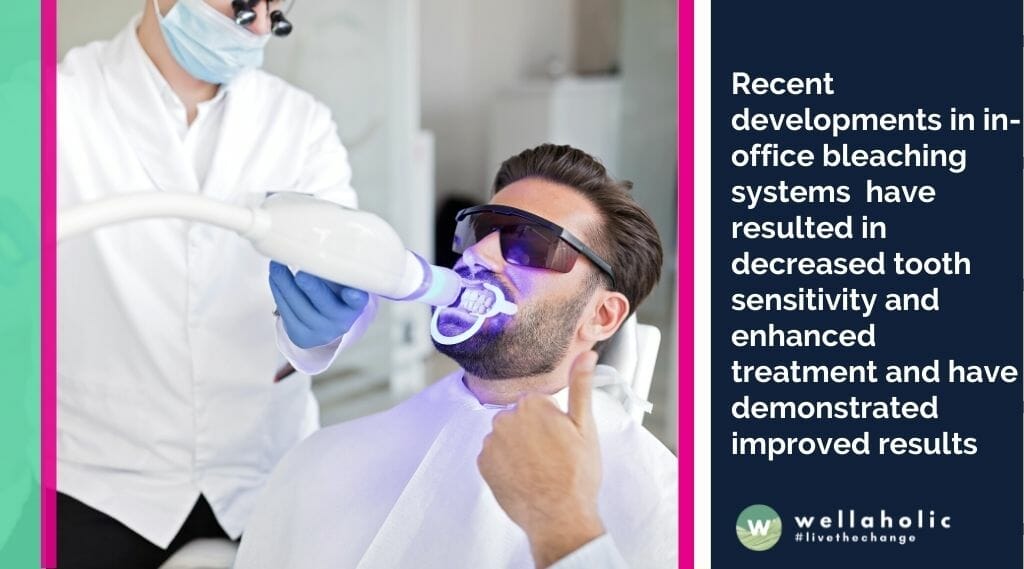
Wellaholic Research: The effect of light-activation sources on tooth bleaching
Abstract
Vital bleaching is one of the most requested cosmetic dental procedures asked by patients who seek a more pleasing smile. This procedure consists of carbamide or hydrogen peroxide gel applications that can be applied in-office or by the patient (at-home/overnight bleaching system). Some in-office treatments utilise whitening light with the objective of speeding up the whitening process. The objective of this article is to review and summarise the current literature with regard to the effect of light-activation sources on in-office tooth bleaching. A literature search was conducted using Medline, accessed via the National Library of Medicine Pub Med from 2003 to 2013 searching for articles relating to effectiveness of light activation sources on in-office tooth bleaching. This study found conflicting evidence on whether light truly improve tooth whitening. Other factors such as, type of stain, initial tooth colour and subject age which can influence tooth bleaching outcome were discussed. Conclusions: The use of light activator sources with in-office bleaching treatment of vital teeth did not increase the efficacy of bleaching or accelerate the bleaching.
Introduction
The causes of tooth discolouration are usually various and multifaceted. They have been classified as extrinsic, intrinsic and internalised discolouration.1 The extrinsic discolouration is associated with the use of tea, coffee, tobacco, some foods such as blueberries, and red wine.2 Intrinsic stains (dentin staining) may be due to systemic conditions, use of medications after the permanent teeth have erupted (e.g., minocycline) or during their development (tetracycline), childhood diseases, infection or trauma to a primary tooth while the underlying tooth is developing, trauma to a permanent tooth or natural aging changes and the accumulation of stain that has entered the teeth.1
There is an increase in patient awareness of the ability to improve the appearance of their discoloured teeth. Not only these patients are seeking to improve the esthetic appearance of their smiles, they are also seeking an effective method. There are several ways to manage tooth discolouration, which include crowns, veneers, or tooth bleaching. For crowns and veneers, these treatment options entail a moderate loss of dental hard tissue. Vital tooth bleaching is not only a less costly alternative to bonded restorative dentistry; it is a conservative and non-invasive technique which has been well accepted to be safe and effective.3
Tooth bleaching using oxalic acid was first introduced in 18484, followed by hydrogen peroxide (HP) in 1884.5 Contemporary, tooth bleaching systems are primarily based on oxidation by HP or one of its precursors such as, carbamide peroxide (CP).6 Hydrogen peroxide releases oxygen that breaks down conjugated bonds in protein chains associated with stain into a single bond. This will result in more absorption of colour wavelengths and resulting in the reflection of little colour (i.e., a whitening effect).2 In the meantime, various treatment modalities are available which include over-the-counter bleaching (self-administered), in-office bleaching (professionally administered) and dentist supervised take-home bleaching (professionally dispensed).7

Home bleaching
Home bleaching is considered a safe and effective treatment.8,9,10 This technique is performed with low concentration hydrogen peroxide (4%-8%) or carbamide peroxide (10%-22%) formulations, which are inserted into trays. These trays are placed in the mouth for 2-8 hours per day, over the course of 2-6 weeks.11
Over-the-counter bleaching
An OTC, 5.3% hydrogen peroxide-coated polyethylene strip (Crest Whitestrips, Procter & Gamble) was recently introduced to the market. According to the manufacturer’s instruction, the patient applies two strips per day for 30 minutes each. A similar 6.5% hydrogen peroxide-coated strip is available by prescription. Clinical studies comparing the whitening efficacy of 10% carbamide peroxide (which breaks down in 3.5% hydrogen peroxide) with the efficacy of the hydrogen peroxide-coated strips have demonstrated that the polyethylene strips may be an acceptable alternative to the night guard method of at-home whitening.12
In-office bleaching
Although in-office bleaching is performed using high concentration hydrogen peroxide (15%-40%),12 it becomes a widely used procedure because of these advantages: Minimally invasive, immediate visible results and no need of patient cooperation.13 Also, in-office whitening is the best for patients who need close monitoring for clinical conditions such as pronounced gingival recession or deep, unrestored abfraction lesions, and necessary for tooth discolouration associated with endodontic therapy.2
Since the introduction of in-office bleaching treatments, the use of curing lights (including halogen curing lights, plasma arches, LED, LED plus lasers, lasers) has been recommended to accelerate the action of the bleaching gel.14 It is believed that most light sources decompose peroxide faster (by increasing the temperature) to form free radicals which whiten teeth.15,16,17
However, some studies reported that the use of light sources did not improve the in-office bleaching treatment of vital teeth.17,18 The clinical results obtained with the use of these lights were poor, showing an increase in tooth sensitivity and reduced long-term colour stability, especially when the treatment was done in one appointment.14 Recent developments in in-office bleaching systems that use a chemical catalyst combined with light-cured block-out materials and compounds have resulted in decreased tooth sensitivity and enhanced treatment and have demonstrated improved results.18 Therefore, the aim of this paper is to review the current literature to evaluate the effect of light-activation sources on in-office tooth bleaching.
With the help of currently available literature, the electronic database “the National Library of Medicine” PubMed was searched for scientific articles relating to effectiveness of light activation sources on in-office tooth bleaching. The search was carried out between 2003 and 2013.

Colour evaluation
Before and after bleaching, the shade is usually assessed using two different methods: Vita Shade Guide, and a spectrophotometer.5
Standard Vita Shade Guide
This is a visual and subjective assessment method. The investigator conduct all the shade comparisons using a standard Vita Shade Guide (Vita Zahnfabrik, Germany) before and after bleaching. Shade guide tabs are arranged from B1to C4, each corresponding to a numerical value from 1 to16, the smaller the numeric value the lighter the tooth.5 This method is the most common, as it is a quick, simple procedure and has been used successfully in many studies.10,19,20,21,22,23
Spectrophotometer
This is an instrumental method for shade matching and has been preferred over the visual evaluation, because it makes the process more practical and statistically more reliable.14 Spectrophotometric colour measurement of specimens was based on the CIE L*a*b* system. The L*a*b* system organises all existing colours within a three-dimensional colour space. L* represents the degree of lightness and ranges from 0 (black) to 100 (white); a* represents the green-red axis while b* represents the blue-yellow axis.5
This system was defined by the International Commission on Illumination in 196724 and is referred to as CIE Lab. The colour comparison before and after treatment is given by the differences between the two colours (ΔE), which is calculated using the formula:
ΔE = [(ΔL*)2 + (Δa*)2 + (Δb*)2]1/2
The effect of light-activation sources on in-office tooth bleaching
Strong controversy surrounds the success of light sources has been detected. Some researchers believe that it is effective in the bleaching process, while others believe only certain lights are effective and others reported no effect.


Hein et al., 200325 reported no difference in the whitening effect of bleaching gels [25%-35% (HP)] with or without three different lights (LumaArch, Optilux 500, and Zoom!). They concluded that the proprietary chemicals added to the bleaching gels acted as catalysts in the whitening process and were solely responsible for activation, where as the lights had no influence.
Luk et al., 200418 reported that colour change were significantly affected by inter action of the bleaching and light variables, and the application of light significantly improved the whitening efficacy of same bleaching materials. Kugel et al., 200635 reported that the use of light did not demonstrate any benefit over the chemically activated tooth whitening system after a 2-week recall. Marson et al., 200814 reported that the in-office bleaching treatment of vital teeth with 35% hydrogen peroxide did not show improvement with the use of any auxiliary sources tested (halogen light, LED, LED/Laser).
Lima et al., 200917 summarised that non-activated whitening did not differ from activated whitening. Where, approximately 35% HP was used with different light sources (LED/diode laser, a halogen lamp, plasma arc lamp, argon laser). Bruzell et al., 200942 reported no difference in efficacy between teeth bleached with or without irradiation for any of the products. The inspection of teeth was performed one week after bleaching using seven bleaching products with or without simultaneous use of seven different bleaching lamps.
Bernardon et al., 201036 reported that similar results were observed when teeth bleached using the in-office technique and light irradiation were compared to teeth bleached without light irradiation to evaluating the clinical performance of 35% HP bleaching gel with and without use of LED/Laser unit. In a study of Browning and Swift 201143 of power bleaching it was stated that light sources used in tooth whitening do not generate sufficient heat to damage teeth. They concluded that high concentrations of chemicals are responsible for faster whitening and that light sources are therefore superfluous in the whitening process.
Torres et al., 201129 reported that bleaching is more effective with a hybrid light-emitting diode (LED) and a low-intensity infrared diode laser than the control group. This research evaluated the effectiveness of the colour change of hybrid LED and low-intensity infrared diode laser devices for activating dental bleaching, bleaching without light, and bleaching with halogen light. Domνnguez et al., 201130 reported that only the diode laser, halogen lamp and LED lamp showed significant colour changes when using six different photo activation systems on three different 35% hydrogen peroxide whiteners. It was concluded that the light source is more important than the bleaching agent in the whitening process.

Kossatz et al., 201131 reported a larger difference in bleaching with a LED/laser than without it on 35% HP gel after the first session of bleaching, but after two sessions, the use of LED/laser light activation did not improve bleaching speed. He et al., 201237 reported that a light-activated system produced better immediate bleaching effects than a non-light system with lower concentrations of hydrogen peroxide. When high concentrations of HP (25-35%) were employed, there was no difference in the immediate bleaching effect or short-term bleaching effect between the light-activated system and the non-light system.
Hahn et al., 201332 could not find an improvement in tooth whitening as a result of LED or laser light treatments, when evaluating the colour stability of bleaching with Opalescence Xtra Boost (38% hydrogen peroxide) using four different methods: activation with halogen, LED, laser or chemical activation. Polydorou et al., 201339 reported that directly after bleaching, the use of halogen showed better results than laser (P ≤ 0.05), on evaluating the colour stability of vital bleaching using a halogen unit, laser, or only chemical activation up to 3 months after treatment.
Liang et al., 201340 concluded that halogen light and chemically activated in-office bleaching systems were both effective for tooth whitening; however, halogen light activation could improve the immediate tooth whitening.
Nuttera et al., 201338 reported that there was no significant difference in shade change between in-office bleaching with light activated 25% hydrogen peroxide gel followed by 2 weeks at home, night-time bleaching with 10% carbamide peroxide gel in a customised bleaching tray and in-office bleaching with 25% hydrogen peroxide without light activation followed by 2 weeks at home, night time bleaching with 10% carbamide peroxide gel in a customised bleaching tray.
Henry et al., 201341 reported that on a split-mouth design study, the use of a sodium arc bulb lamp with 25% hydrogen peroxide for in-office whitening produces better results on maxillary teeth up to 1 week after whitening is completed. Using only gel for whitening could not distinguish differences on each side of the mouth.
Conclusion
The in-office bleaching treatment of vital teeth did not show improvement with the use of light activator sources for the purpose of accelerating the process of the bleaching gel and achieving better results.
Source
- National Library of Medicine v.55(5); Sep-Oct 2014 PMC4178330
- Efficacy of Dental Bleaching with Whitening Dentifrices: A Systematic Review
- Kusai Baroudi and Nadia Aly Hassan
TeethWhite by Wellaholic
TeethWhite™ is a premium laser teeth whitening treatment in Singapore. TeethWhite™ can whiten your teeth by up to 12 shades with immediate results, regardless of color of teeth. The treatment is safe and suitable for sensitive teeth. The primary ingredient in teeth whitening gel is Carbamide Peroxide. The molecules will convert to hydrogen peroxide and become active when exposed to your teeth and with strong LED light technology. This whitens your teeth thoroughly, leading to beautiful teeth.
WHAT IS TEETHWHITE™?
- TeethWhite™ is a premium laser teeth whitening treatment in Singapore, offered at all Wellaholic outlets.
- Your teeth have pores just like your skin.
- The nicotine and tar, as well as surface stains from coffee and tea and other beverages, can easily stain your teeth over time, leading to teeth discoloration.
- The primary ingredient in teeth whitening gel is Carbamide Peroxide.
- The molecules will convert to hydrogen peroxide and become active when exposed to your teeth and with strong LED light.
- The teeth whitening procedure helps target your teeth stains and whitens your teeth thoroughly.
- You can see immediate whitening results right after the teeth whitening treatment, resulting in beautiful teeth.
- The whitening effect continues over a period of time, leading to a brighter smile and white smile.

IS WELLAHOLIC’S TEETHWHITE™ BACKED BY SCIENCE?
- TeethWhite™ is a method of teeth whitening or teeth bleaching treatment in Singapore.
- The teeth whitening treatment uses the LED blue light and red light to activate the teeth whitening gel.
- The 6000w industrial lamp helps catalyse the whitening agent to speed up the reaction and causing free oxygen radicals to be formed. This makes the treatment more effective than teeth whitening kits.
- Any discoloration in the tooth enamel or tooth colour (teeth with external stains) can be removed effectively.
- This aesthetic treatment leads to brighter teeth and whiter teeth, for more a beautiful smile.





